Analysis of Intellectual Property Management in Open Innovation
VerifiedAdded on 2021/04/17
|7
|1473
|65
Report
AI Summary
This report delves into the critical role of intellectual property (IP) management within the open innovation model, focusing on the advantages and challenges faced by small and medium-sized enterprises (SMEs). It highlights the increasing importance of IP in technological advancements and the necessity for companies to leverage third-party IP to drive innovation. The report provides a comprehensive overview of open innovation, emphasizing the benefits such as risk sharing, cost reduction, and enhanced market access. It analyzes the concept of multi-invention factors and the collaboration between firms to facilitate innovation. Furthermore, the report underscores the significance of strong IP management to prevent the leakage of intangible assets, especially through measures like confidentiality agreements, consortium agreements, and IP audits. It also examines strategies such as licensing, IP due diligence, and the assignment of IP rights to safeguard innovation and maximize benefits within the open innovation framework.
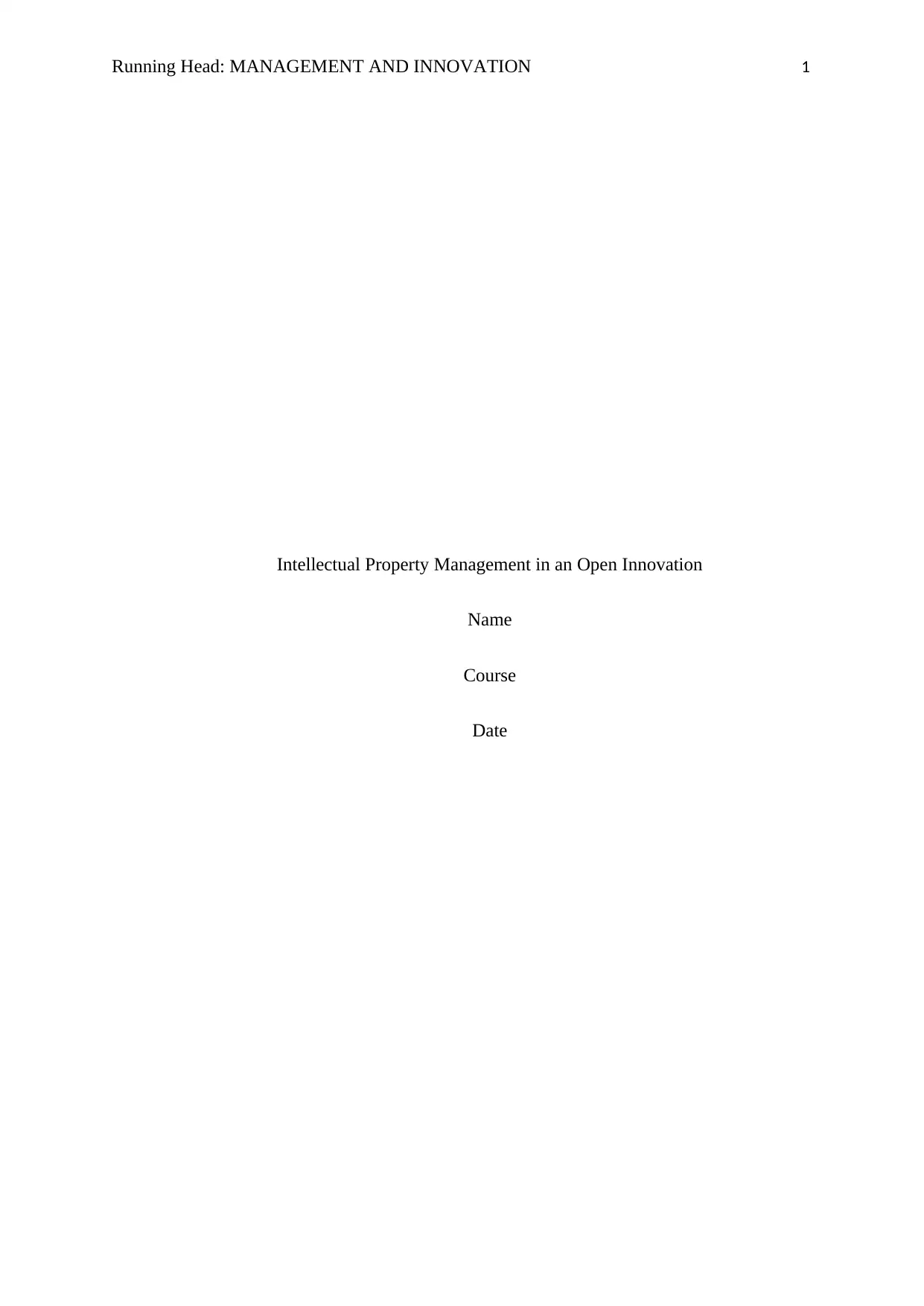
Running Head: MANAGEMENT AND INNOVATION 1
Intellectual Property Management in an Open Innovation
Name
Course
Date
Intellectual Property Management in an Open Innovation
Name
Course
Date
Paraphrase This Document
Need a fresh take? Get an instant paraphrase of this document with our AI Paraphraser
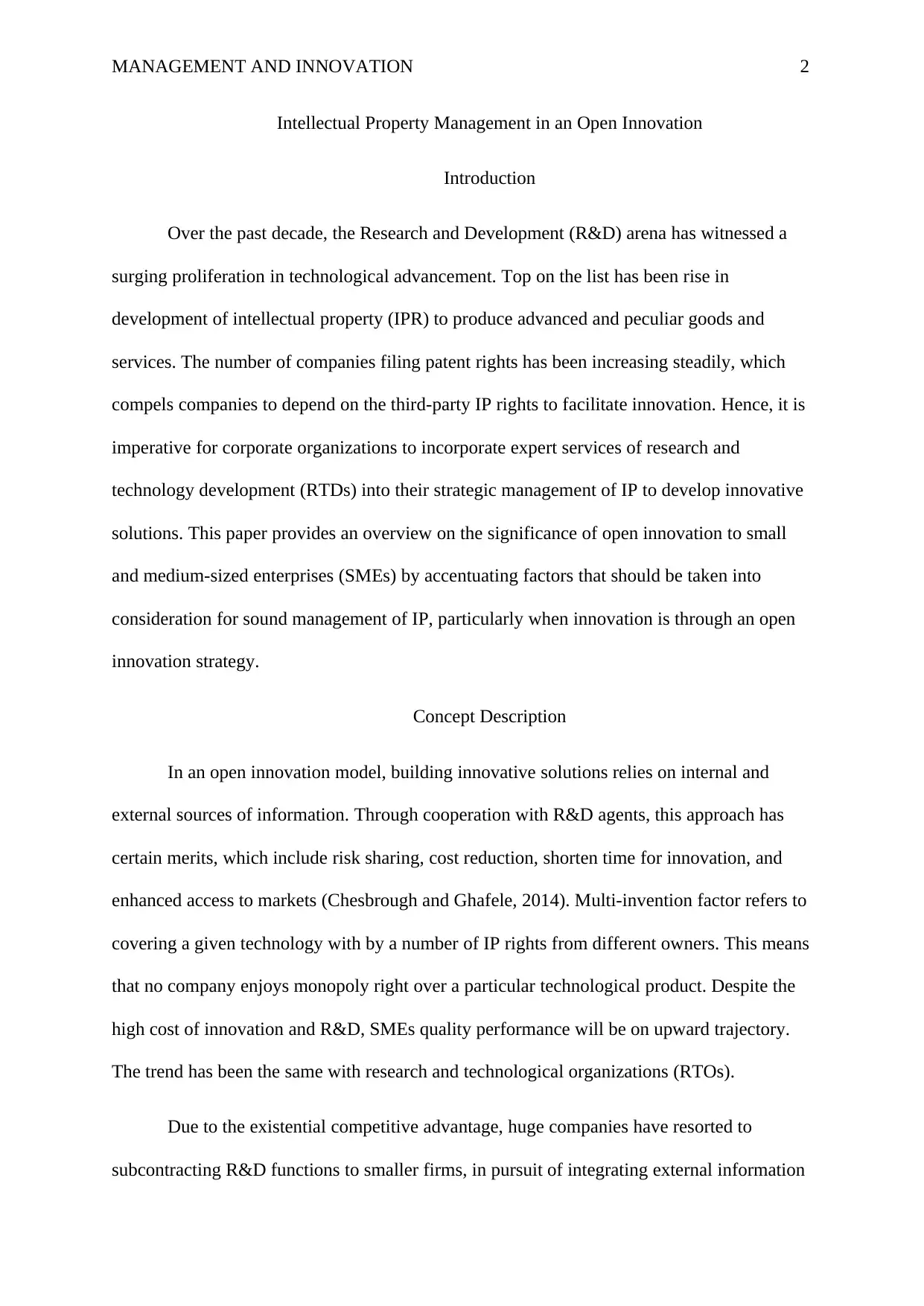
MANAGEMENT AND INNOVATION 2
Intellectual Property Management in an Open Innovation
Introduction
Over the past decade, the Research and Development (R&D) arena has witnessed a
surging proliferation in technological advancement. Top on the list has been rise in
development of intellectual property (IPR) to produce advanced and peculiar goods and
services. The number of companies filing patent rights has been increasing steadily, which
compels companies to depend on the third-party IP rights to facilitate innovation. Hence, it is
imperative for corporate organizations to incorporate expert services of research and
technology development (RTDs) into their strategic management of IP to develop innovative
solutions. This paper provides an overview on the significance of open innovation to small
and medium-sized enterprises (SMEs) by accentuating factors that should be taken into
consideration for sound management of IP, particularly when innovation is through an open
innovation strategy.
Concept Description
In an open innovation model, building innovative solutions relies on internal and
external sources of information. Through cooperation with R&D agents, this approach has
certain merits, which include risk sharing, cost reduction, shorten time for innovation, and
enhanced access to markets (Chesbrough and Ghafele, 2014). Multi-invention factor refers to
covering a given technology with by a number of IP rights from different owners. This means
that no company enjoys monopoly right over a particular technological product. Despite the
high cost of innovation and R&D, SMEs quality performance will be on upward trajectory.
The trend has been the same with research and technological organizations (RTOs).
Due to the existential competitive advantage, huge companies have resorted to
subcontracting R&D functions to smaller firms, in pursuit of integrating external information
Intellectual Property Management in an Open Innovation
Introduction
Over the past decade, the Research and Development (R&D) arena has witnessed a
surging proliferation in technological advancement. Top on the list has been rise in
development of intellectual property (IPR) to produce advanced and peculiar goods and
services. The number of companies filing patent rights has been increasing steadily, which
compels companies to depend on the third-party IP rights to facilitate innovation. Hence, it is
imperative for corporate organizations to incorporate expert services of research and
technology development (RTDs) into their strategic management of IP to develop innovative
solutions. This paper provides an overview on the significance of open innovation to small
and medium-sized enterprises (SMEs) by accentuating factors that should be taken into
consideration for sound management of IP, particularly when innovation is through an open
innovation strategy.
Concept Description
In an open innovation model, building innovative solutions relies on internal and
external sources of information. Through cooperation with R&D agents, this approach has
certain merits, which include risk sharing, cost reduction, shorten time for innovation, and
enhanced access to markets (Chesbrough and Ghafele, 2014). Multi-invention factor refers to
covering a given technology with by a number of IP rights from different owners. This means
that no company enjoys monopoly right over a particular technological product. Despite the
high cost of innovation and R&D, SMEs quality performance will be on upward trajectory.
The trend has been the same with research and technological organizations (RTOs).
Due to the existential competitive advantage, huge companies have resorted to
subcontracting R&D functions to smaller firms, in pursuit of integrating external information
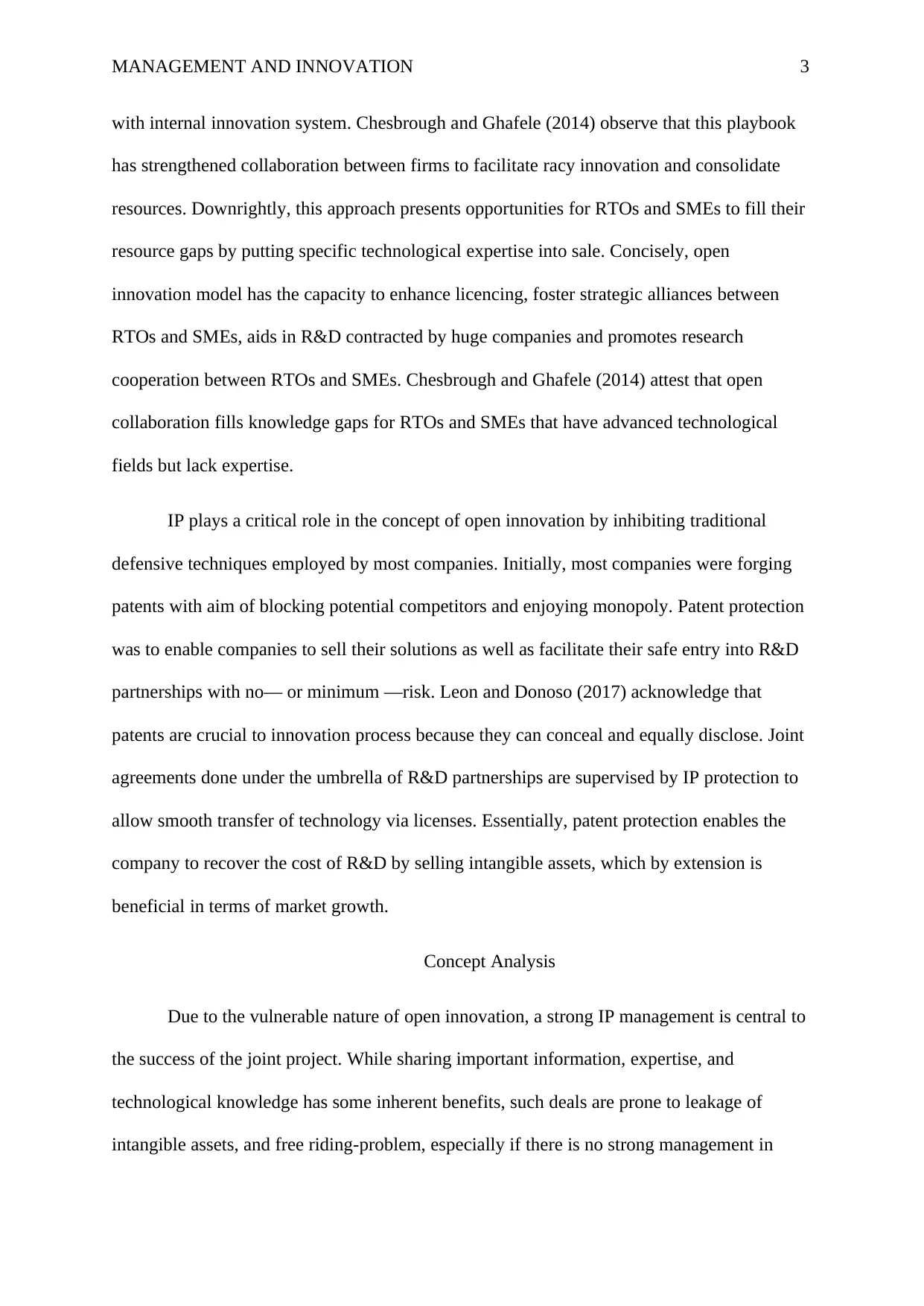
MANAGEMENT AND INNOVATION 3
with internal innovation system. Chesbrough and Ghafele (2014) observe that this playbook
has strengthened collaboration between firms to facilitate racy innovation and consolidate
resources. Downrightly, this approach presents opportunities for RTOs and SMEs to fill their
resource gaps by putting specific technological expertise into sale. Concisely, open
innovation model has the capacity to enhance licencing, foster strategic alliances between
RTOs and SMEs, aids in R&D contracted by huge companies and promotes research
cooperation between RTOs and SMEs. Chesbrough and Ghafele (2014) attest that open
collaboration fills knowledge gaps for RTOs and SMEs that have advanced technological
fields but lack expertise.
IP plays a critical role in the concept of open innovation by inhibiting traditional
defensive techniques employed by most companies. Initially, most companies were forging
patents with aim of blocking potential competitors and enjoying monopoly. Patent protection
was to enable companies to sell their solutions as well as facilitate their safe entry into R&D
partnerships with no— or minimum —risk. Leon and Donoso (2017) acknowledge that
patents are crucial to innovation process because they can conceal and equally disclose. Joint
agreements done under the umbrella of R&D partnerships are supervised by IP protection to
allow smooth transfer of technology via licenses. Essentially, patent protection enables the
company to recover the cost of R&D by selling intangible assets, which by extension is
beneficial in terms of market growth.
Concept Analysis
Due to the vulnerable nature of open innovation, a strong IP management is central to
the success of the joint project. While sharing important information, expertise, and
technological knowledge has some inherent benefits, such deals are prone to leakage of
intangible assets, and free riding-problem, especially if there is no strong management in
with internal innovation system. Chesbrough and Ghafele (2014) observe that this playbook
has strengthened collaboration between firms to facilitate racy innovation and consolidate
resources. Downrightly, this approach presents opportunities for RTOs and SMEs to fill their
resource gaps by putting specific technological expertise into sale. Concisely, open
innovation model has the capacity to enhance licencing, foster strategic alliances between
RTOs and SMEs, aids in R&D contracted by huge companies and promotes research
cooperation between RTOs and SMEs. Chesbrough and Ghafele (2014) attest that open
collaboration fills knowledge gaps for RTOs and SMEs that have advanced technological
fields but lack expertise.
IP plays a critical role in the concept of open innovation by inhibiting traditional
defensive techniques employed by most companies. Initially, most companies were forging
patents with aim of blocking potential competitors and enjoying monopoly. Patent protection
was to enable companies to sell their solutions as well as facilitate their safe entry into R&D
partnerships with no— or minimum —risk. Leon and Donoso (2017) acknowledge that
patents are crucial to innovation process because they can conceal and equally disclose. Joint
agreements done under the umbrella of R&D partnerships are supervised by IP protection to
allow smooth transfer of technology via licenses. Essentially, patent protection enables the
company to recover the cost of R&D by selling intangible assets, which by extension is
beneficial in terms of market growth.
Concept Analysis
Due to the vulnerable nature of open innovation, a strong IP management is central to
the success of the joint project. While sharing important information, expertise, and
technological knowledge has some inherent benefits, such deals are prone to leakage of
intangible assets, and free riding-problem, especially if there is no strong management in
⊘ This is a preview!⊘
Do you want full access?
Subscribe today to unlock all pages.

Trusted by 1+ million students worldwide
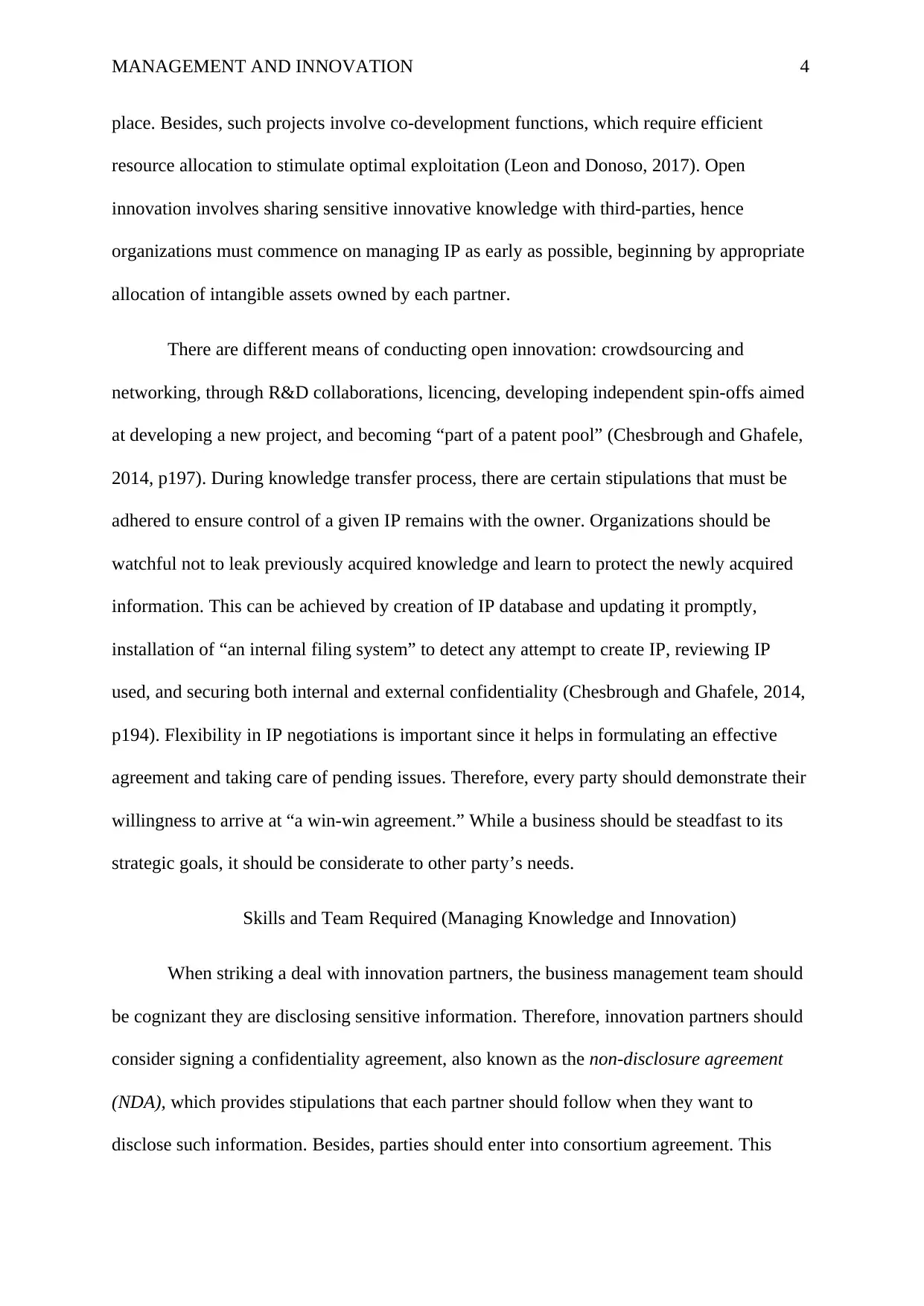
MANAGEMENT AND INNOVATION 4
place. Besides, such projects involve co-development functions, which require efficient
resource allocation to stimulate optimal exploitation (Leon and Donoso, 2017). Open
innovation involves sharing sensitive innovative knowledge with third-parties, hence
organizations must commence on managing IP as early as possible, beginning by appropriate
allocation of intangible assets owned by each partner.
There are different means of conducting open innovation: crowdsourcing and
networking, through R&D collaborations, licencing, developing independent spin-offs aimed
at developing a new project, and becoming “part of a patent pool” (Chesbrough and Ghafele,
2014, p197). During knowledge transfer process, there are certain stipulations that must be
adhered to ensure control of a given IP remains with the owner. Organizations should be
watchful not to leak previously acquired knowledge and learn to protect the newly acquired
information. This can be achieved by creation of IP database and updating it promptly,
installation of “an internal filing system” to detect any attempt to create IP, reviewing IP
used, and securing both internal and external confidentiality (Chesbrough and Ghafele, 2014,
p194). Flexibility in IP negotiations is important since it helps in formulating an effective
agreement and taking care of pending issues. Therefore, every party should demonstrate their
willingness to arrive at “a win-win agreement.” While a business should be steadfast to its
strategic goals, it should be considerate to other party’s needs.
Skills and Team Required (Managing Knowledge and Innovation)
When striking a deal with innovation partners, the business management team should
be cognizant they are disclosing sensitive information. Therefore, innovation partners should
consider signing a confidentiality agreement, also known as the non-disclosure agreement
(NDA), which provides stipulations that each partner should follow when they want to
disclose such information. Besides, parties should enter into consortium agreement. This
place. Besides, such projects involve co-development functions, which require efficient
resource allocation to stimulate optimal exploitation (Leon and Donoso, 2017). Open
innovation involves sharing sensitive innovative knowledge with third-parties, hence
organizations must commence on managing IP as early as possible, beginning by appropriate
allocation of intangible assets owned by each partner.
There are different means of conducting open innovation: crowdsourcing and
networking, through R&D collaborations, licencing, developing independent spin-offs aimed
at developing a new project, and becoming “part of a patent pool” (Chesbrough and Ghafele,
2014, p197). During knowledge transfer process, there are certain stipulations that must be
adhered to ensure control of a given IP remains with the owner. Organizations should be
watchful not to leak previously acquired knowledge and learn to protect the newly acquired
information. This can be achieved by creation of IP database and updating it promptly,
installation of “an internal filing system” to detect any attempt to create IP, reviewing IP
used, and securing both internal and external confidentiality (Chesbrough and Ghafele, 2014,
p194). Flexibility in IP negotiations is important since it helps in formulating an effective
agreement and taking care of pending issues. Therefore, every party should demonstrate their
willingness to arrive at “a win-win agreement.” While a business should be steadfast to its
strategic goals, it should be considerate to other party’s needs.
Skills and Team Required (Managing Knowledge and Innovation)
When striking a deal with innovation partners, the business management team should
be cognizant they are disclosing sensitive information. Therefore, innovation partners should
consider signing a confidentiality agreement, also known as the non-disclosure agreement
(NDA), which provides stipulations that each partner should follow when they want to
disclose such information. Besides, parties should enter into consortium agreement. This
Paraphrase This Document
Need a fresh take? Get an instant paraphrase of this document with our AI Paraphraser
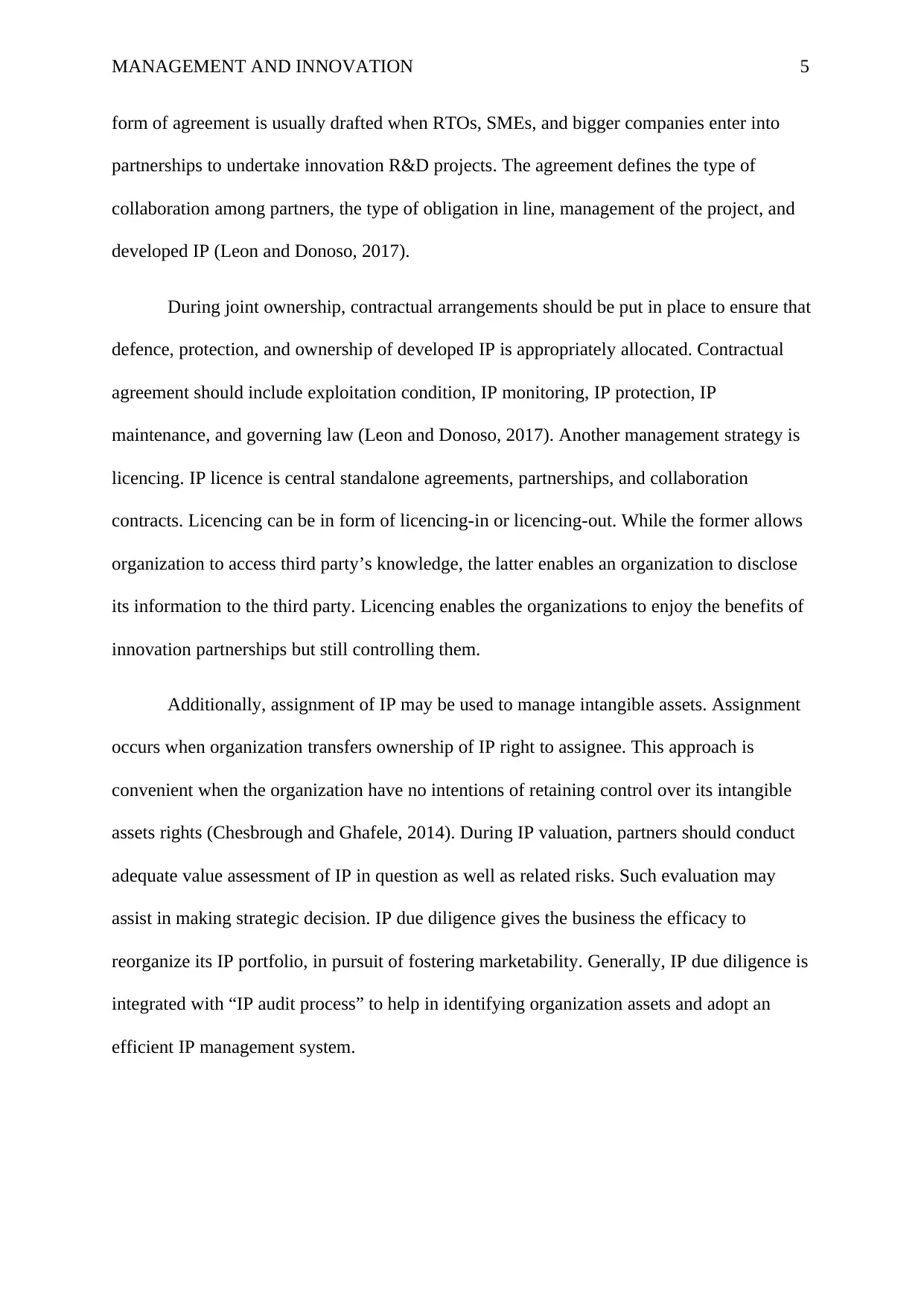
MANAGEMENT AND INNOVATION 5
form of agreement is usually drafted when RTOs, SMEs, and bigger companies enter into
partnerships to undertake innovation R&D projects. The agreement defines the type of
collaboration among partners, the type of obligation in line, management of the project, and
developed IP (Leon and Donoso, 2017).
During joint ownership, contractual arrangements should be put in place to ensure that
defence, protection, and ownership of developed IP is appropriately allocated. Contractual
agreement should include exploitation condition, IP monitoring, IP protection, IP
maintenance, and governing law (Leon and Donoso, 2017). Another management strategy is
licencing. IP licence is central standalone agreements, partnerships, and collaboration
contracts. Licencing can be in form of licencing-in or licencing-out. While the former allows
organization to access third party’s knowledge, the latter enables an organization to disclose
its information to the third party. Licencing enables the organizations to enjoy the benefits of
innovation partnerships but still controlling them.
Additionally, assignment of IP may be used to manage intangible assets. Assignment
occurs when organization transfers ownership of IP right to assignee. This approach is
convenient when the organization have no intentions of retaining control over its intangible
assets rights (Chesbrough and Ghafele, 2014). During IP valuation, partners should conduct
adequate value assessment of IP in question as well as related risks. Such evaluation may
assist in making strategic decision. IP due diligence gives the business the efficacy to
reorganize its IP portfolio, in pursuit of fostering marketability. Generally, IP due diligence is
integrated with “IP audit process” to help in identifying organization assets and adopt an
efficient IP management system.
form of agreement is usually drafted when RTOs, SMEs, and bigger companies enter into
partnerships to undertake innovation R&D projects. The agreement defines the type of
collaboration among partners, the type of obligation in line, management of the project, and
developed IP (Leon and Donoso, 2017).
During joint ownership, contractual arrangements should be put in place to ensure that
defence, protection, and ownership of developed IP is appropriately allocated. Contractual
agreement should include exploitation condition, IP monitoring, IP protection, IP
maintenance, and governing law (Leon and Donoso, 2017). Another management strategy is
licencing. IP licence is central standalone agreements, partnerships, and collaboration
contracts. Licencing can be in form of licencing-in or licencing-out. While the former allows
organization to access third party’s knowledge, the latter enables an organization to disclose
its information to the third party. Licencing enables the organizations to enjoy the benefits of
innovation partnerships but still controlling them.
Additionally, assignment of IP may be used to manage intangible assets. Assignment
occurs when organization transfers ownership of IP right to assignee. This approach is
convenient when the organization have no intentions of retaining control over its intangible
assets rights (Chesbrough and Ghafele, 2014). During IP valuation, partners should conduct
adequate value assessment of IP in question as well as related risks. Such evaluation may
assist in making strategic decision. IP due diligence gives the business the efficacy to
reorganize its IP portfolio, in pursuit of fostering marketability. Generally, IP due diligence is
integrated with “IP audit process” to help in identifying organization assets and adopt an
efficient IP management system.
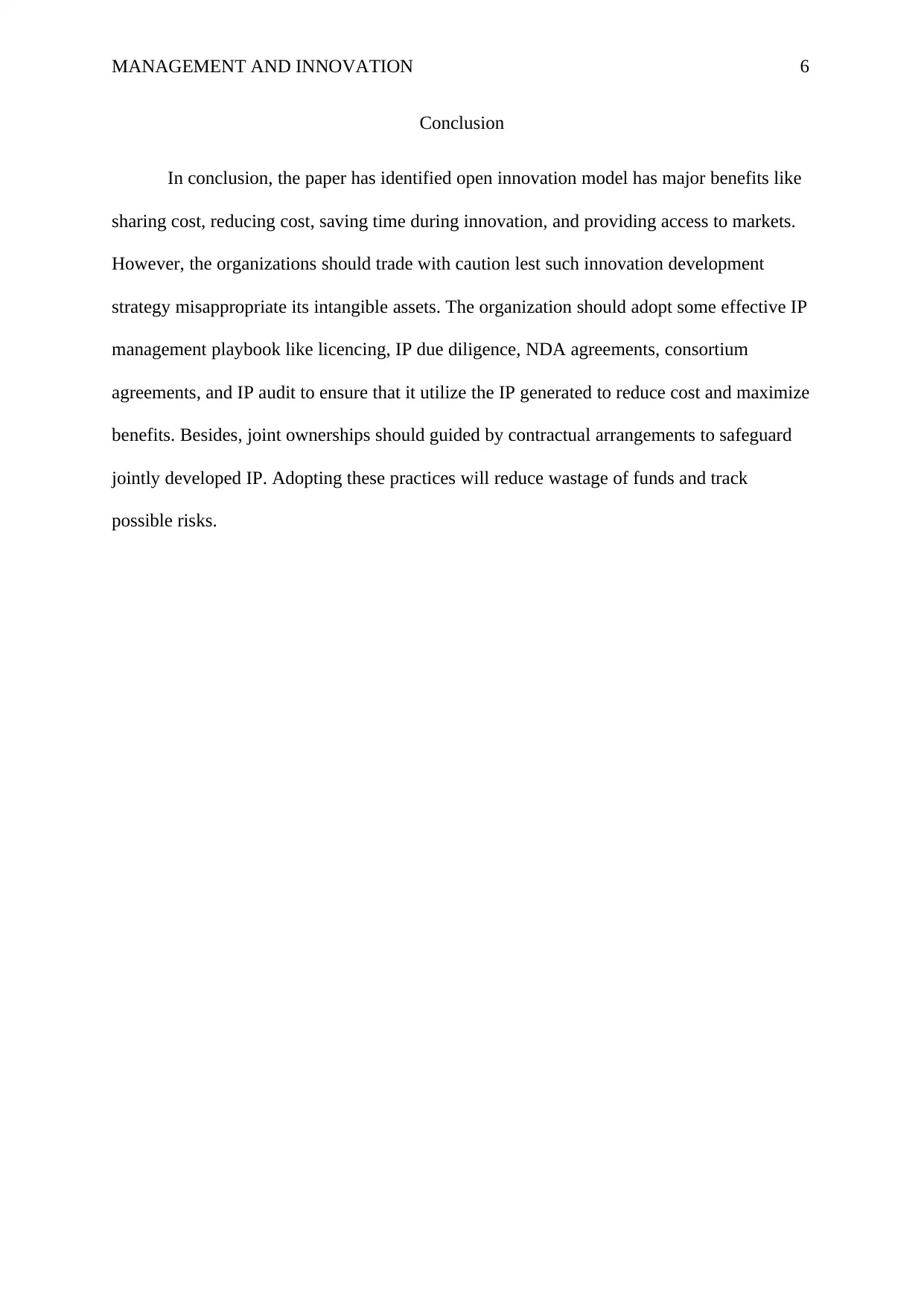
MANAGEMENT AND INNOVATION 6
Conclusion
In conclusion, the paper has identified open innovation model has major benefits like
sharing cost, reducing cost, saving time during innovation, and providing access to markets.
However, the organizations should trade with caution lest such innovation development
strategy misappropriate its intangible assets. The organization should adopt some effective IP
management playbook like licencing, IP due diligence, NDA agreements, consortium
agreements, and IP audit to ensure that it utilize the IP generated to reduce cost and maximize
benefits. Besides, joint ownerships should guided by contractual arrangements to safeguard
jointly developed IP. Adopting these practices will reduce wastage of funds and track
possible risks.
Conclusion
In conclusion, the paper has identified open innovation model has major benefits like
sharing cost, reducing cost, saving time during innovation, and providing access to markets.
However, the organizations should trade with caution lest such innovation development
strategy misappropriate its intangible assets. The organization should adopt some effective IP
management playbook like licencing, IP due diligence, NDA agreements, consortium
agreements, and IP audit to ensure that it utilize the IP generated to reduce cost and maximize
benefits. Besides, joint ownerships should guided by contractual arrangements to safeguard
jointly developed IP. Adopting these practices will reduce wastage of funds and track
possible risks.
⊘ This is a preview!⊘
Do you want full access?
Subscribe today to unlock all pages.

Trusted by 1+ million students worldwide

MANAGEMENT AND INNOVATION 7
References
Chesbrough, H., & Ghafele, R. (2014). Open Innovation and Intellectual Property. New
Frontiers in Open Innovation, 191-207.
Leon, I., & Donoso, J. (2017). Innovation, Start-ups and Intellectual Property Management
References
Chesbrough, H., & Ghafele, R. (2014). Open Innovation and Intellectual Property. New
Frontiers in Open Innovation, 191-207.
Leon, I., & Donoso, J. (2017). Innovation, Start-ups and Intellectual Property Management
1 out of 7
Related Documents
Your All-in-One AI-Powered Toolkit for Academic Success.
+13062052269
info@desklib.com
Available 24*7 on WhatsApp / Email
![[object Object]](/_next/static/media/star-bottom.7253800d.svg)
Unlock your academic potential
Copyright © 2020–2025 A2Z Services. All Rights Reserved. Developed and managed by ZUCOL.





